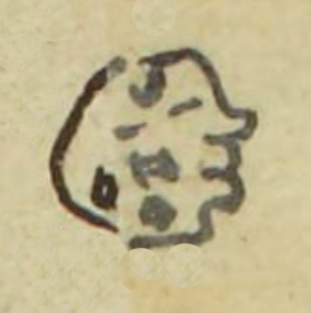Cuicuil (MH526v)
This black-line drawing of the simplex glyph for the personal name Cuicuil (perhaps “Freckled,” of "Pock Marked," attested here as a man’s name) shows a profile view of a bald person's head with attention to the spots on the face, some of which are large and therefore more like moles or pocks than freckles.
Stephanie Wood
Looking at terms in the dictionary, cuicuiltic, something painted in the way a pinto horse is spotted, perhaps. Another term, ixchian cuicuillotl, specifically applies to the face, which justifies the use of cuicuiltic in consideration of markings on the face.
Marc Thouvenot identifies the verb icuiloa (or ihcuiloa, with the glottal stop), which means to paint, write, or print, as having a root of -cuil-. He notes how it also appears in tlacuiloliztli (writing), tlacuilo (writer), and cuicuiltic (mottled). He goes on to show various uses of icuiloa that take it beyond the simple definitions just given, resulting in something like the action of creating a design (e.g., on leather, ceramics, sculpture, or in textiles). It can also be something like the action of decorating (e.g., to put a flower on a cup of atole). He associates icuiloa and tlacuilolli with "cultural artifacts," such as arts and crafts or examples of writing and painting, but cuicuiltic with effects created by "nature." This short summary barely does his article justice; it is worth reading the entire piece. How Thouvenot's study might connect with the concept of bent or curved mentioned by Prem (1974: 555, 682) raises an interesting question. Perhaps the bent or curved lines of writing, painting, carving, embroidery, and so on, fall with in the realm of expressions of -cuil-. See
Marc Thouvenot, "Imágenes y escritura entre los nahuas del inicio del XVI," Estudios de Cultural Náhuatl 41 (2010).
Stephanie Wood
diego. cuicuil.
Diego Cuicuil
Stephanie Wood
1560
Stephanie Wood
painted, pintado, pecoso, freckled, lunares en la cara, faces, moles

cuicuiltic, painted, spotted, varicolored, https://nahuatl.wired-humanities.org/content/cuicuiltic
ixchian cuicuillotl, moles or freckles on face, https://nahuatl.wired-humanities.org/content/ixchian-cuicuillotl
cuicuiloa, to paint something many colors, https://nahuatl.wired-humanities.org/content/cu%C4%ABcu%C4%ABlo%C4%81
Pecoso
Stephanie Wood
Matrícula de Huexotzinco, folio 526v, World Digital Library, https://www.loc.gov/resource/gdcwdl.wdl_15282/?sp=132&st=image.
This manuscript is hosted by the Library of Congress and the World Digital Library; used here with the Creative Commons, “Attribution-NonCommercial-ShareAlike 3.0 License” (CC-BY-NC-SAq 3.0).





